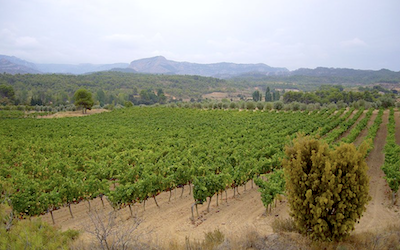We typically focus on a single wine in each review, but on this occasion, the choice of grape—and the dramatic contrast in regional expression—warrants a departure from our usual format.
Cabernet Franc finds a Spanish accent
Cabernet Franc is one of the oldest and most historically significant grape varieties still cultivated today. Likely originating in the Basque country or southwest France, it is best known as a key blending component in Bordeaux and as the signature red grape of the Loire Valley, where it shines in varietal expressions.

Its relatively thin skin and early ripening make it well-suited to cooler climates, where it produces wines known for their aromatic finesse, red berry fruit, floral lift, and distinctive notes of herbs, graphite, and spice.
Beyond France, Cabernet Franc has found success in Italy, the United States, Chile, and parts of Eastern Europe—but its presence in Spain remains rare and unconventional.
While the Spanish wine landscape is dominated by native varieties like Tempranillo, Garnacha and Monastrell, a handful of pioneering producers have explored Cabernet Franc’s potential in select microclimates that balance altitude, diurnal shift, and soil character.
These projects remain exceptions rather than the rule, making varietal Cabernet Franc bottlings in Spain both distinctive and revealing.
It is precisely this rarity—and the grape’s sensitivity to place—that justifies the comparison of two radically different Spanish expressions: Venta d’Aubert Cabernet Franc from Aragón’s Bajo Aragón region, and Finca Los Aljibes Cabernet Franc from the high plains of Castilla-La Mancha. Though both wines are made from the same variety and vinified with care, they emerge from terroirs so different—geologically, climatically, and culturally–that the contrast is striking. This tasting is not just about style or technique, but about how geography and environment imprint themselves on the same grape in two dramatically divergent ways.
Venta d’Aubert Cabernet Franc hails from the limestone-streaked slopes of Bajo Aragón, where a dry continental climate and elevations between 550 and 600 metres create ideal conditions for slow ripening and aromatic precision. This is a serious, age-worthy wine—aged 36 months in predominantly new French oak—that displays a deep, brooding character. Aromas of blackberry, cassis, and forest floor mingle with graphite, tobacco, and a subtle mineral edge. On the palate, it is full-bodied and tightly structured, with firm yet polished tannins and a long, savory finish. This is Cabernet Franc at its most classical: restrained, focused, and deeply expressive of place.
Serve with hearty, slow-cooked, or robustly flavoured food.
92-94 Bruja points EUR28.50 from https://vinopremier.com/
In contrast, Finca Los Aljibes Cabernet Franc is grown in Chinchilla de Montearagón, at nearly 1,000 meters above sea level on the sun-drenched Castilian meseta. While the region is warmer overall, the altitude tempers the heat, preserving acidity and aromatic lift. The resulting wine is more fruit-forward and approachable, offering vibrant notes of ripe red berries, rose petals, and a hint of green herbs. Aged 16 months in French oak, it is medium-bodied, with smooth tannins and a rounded, elegant mouthfeel. On the palate, flavors of black cherry, floral spice, and bell pepper unfold over a clean, mineral finish. This is a modern, generous expression of Cabernet Franc—less austere than its Aragonese counterpart, but equally engaging in its own style.
Serve with aromatic herbs, and Mediterranean-inspired cuisine
94-96 Bruja points EUR11.90 from Olivares in Almuñécar
Together, these two wines reveal the remarkable adaptability of Cabernet Franc in Spain’s evolving viticultural landscape: one rooted in restraint and longevity, the other in aromatic charm and expressive immediacy.
(News/Feature: Wine)
keywords: wine, finca los aljibes, cabernet franc, tempranillo, garnacha, monastrell, venta d’aubert
